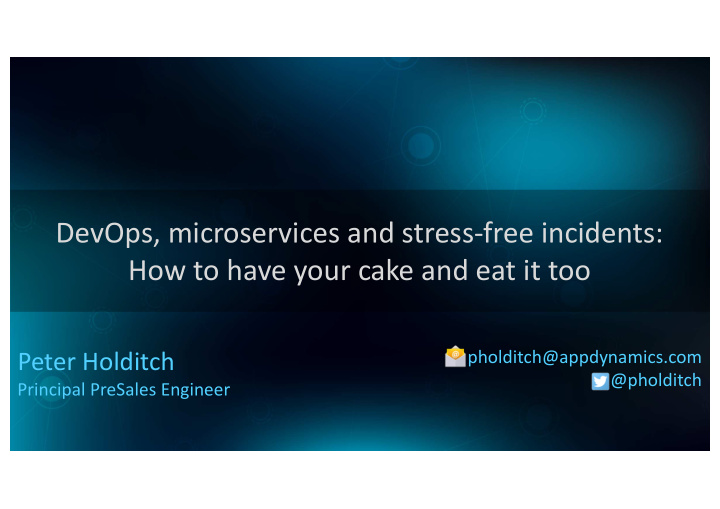



DevOps, microservices and stress-free incidents: How to have your cake and eat it too Peter Holditch pholditch@appdynamics.com @pholditch Principal PreSales Engineer
Have your agenda and eat it too • How did we get here? o Why DevOps o Why Microservices • Where DevOps and miroservices collide • Joint DevOps & microservices management requirements • Delivering these requirements: buy vs build • Business case for buying a solution AppDynamics Confidential and Proprietary 2
Why DevOps? • The rate of change of systems has grown exponentially o 2 releases a year, delivered complete with a big operations manual is not a recipe for high velocity delivery • Keeping systems reliable in the face of this rate of change requires o Automation of the software release (manufacturing) process o Collaboration across the software lifecycle • “traditional ops” run platforms, delivery pipelines • Developers (formally) take responsibility for application troubleshooting in production
Why microservices? • Loose coupling enables agility o Choose best language for the job by service o Different rates of change per service o Different NFRs per service o Easier to coordinate activity within smaller development teams • Focused domain expertise • Better accountability to business stakeholders
Where DevOps and microservices collide • Trade off dev time simplicity vs operational complexity • Troubleshooting : how many technology “throats to choke”? o Triage vs analysis o Is each piece managed in the same way? o Dev time from each team to support => the dreaded war room • Maturity: once a service is stable and the team move on… o Who owns the service now? o Who can troubleshoot it?
Requirements for unified monitoring of microservices • For developers o Language support o Low touch • In implementation and production handover • Provide detailed code level visibility when necessary • For Ops o Ease of use; simplify troubleshooting (“shift left”) Consistency • Comprehensive end to end visibility, fault domain isolation • • For DevOps o Foster dev/ops collaboration o Provide feedback throughout delivery pipeline
Automatically trace application traffic end to end AppDynamics Confidential and Proprietary 7
Support polyglot applications AppDynamics Confidential and Proprietary 8
Identify flow per transaction AppDynamics Confidential and Proprietary 9
Troubleshoot individual transactions… AppDynamics Confidential and Proprietary 10
…down to code level AppDynamics Confidential and Proprietary 11
I can build that myself with ELK / zipkin / … • Sure, it’s only software… Let’s get on with it! o Stand up Elastic Search and suck in your logs. Job done? o Now, standardise your log messages so they’re consistent o Now, flow a transaction identifier end to end and add it to the messages, or use zipkin to trace transactions • That’s several man months of work already... ... and you still have no code level visibility... ... nor any easy to use UI to allow that essential “shift left” • Now imagine you acquire a product or a company L AppDynamics Confidential and Proprietary 12
Bonus: architectural benefits • Architectural governance o Per service dependency analysis o Manage Conway’s law effects • Evolve and manage risk in the system over time • Data for capacity planning • Achieve maturity with less risk of “hitting a wall” • Evolution toward #noops?
The business case for unified monitoring Free 1 dev Save developer time in production troubleshooting • typically between 7-20% of developer time Free .5 dev • Save developer time in performance testing Free .75 dev Save developer time implementing custom monitoring • Free .25 dev Save developer time in production handoff • Ease staff on-boarding • “1 month to 1 day” [SaaS] avoid running costs of monitoring back-ends •
Summary • Microservices shift complexity from development to production • DevOps is not a panacea for production complexity: developers have day jobs! • Production complexity needs to be managed to allow efficient (stress–free) operation • AppDynamics offers an excellent, cost-justifiable, solution to these issues Questions?
Register for a free trial! www.appdynamics.com/free-trial
Recommend
More recommend